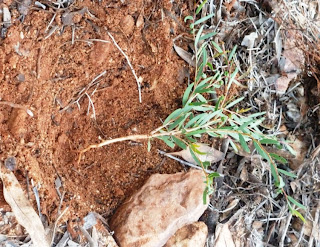The exact requirements are still poorly understood, but germination seems to require periods of above average rainfall, with this rainfall occurring across both Winter and Summer seasons. Typically in central Australia, rainfall events are concentrated in the warm months, with little or no rain occurring in the cool part of the year. There may also be specific temperature requirements as well. This being the case, the germination of seedlings of Ironwood is a rarely observed event.
 |
| Ironwood seedling |
 |
| Seedling root structure |
It is exciting then to report that during a recent property assessment in the Ilparpa area, we were able to identify ironwood seedlings that were approximately 6 months of age. These have germinated in response to the exceptional climatic conditions throughout central Australia in the past 12-18 months. Ironwoods are slow growing and can reproduce by suckering from the roots, so often, small plants of seedling size are in fact much older plants. Some individuals that germinated during the last recorded event in 1973-74 may still be less than 1/2m tall!
The key to identifying a young ironwood seedling is by examining the root system. You can see from the photographs the small tap root quickly branching in to fine lateral roots in the seedling. An older plant will have a much deeper tap root and you may find it difficult to find any lateral roots close to the surface. Of course, plants that are suckering will be attached to the much larger root of a parent tree.
If you think you have new Ironwood seedling on your property, we'd love to know about it. Perhaps carefully dig around the roots to see if it looks similar to the photographs. Take a picture of your own, and send them into us to record this rare and special event.

No comments:
Post a Comment